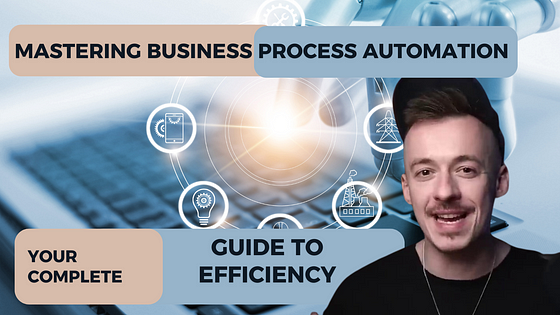
Business process automation (BPA) is the strategic use of technology to automate repetitive, multistep business transactions, thereby increasing efficiency, reducing costs, and enhancing customer satisfaction.
By leveraging software to automate tasks, organizations can streamline workflows, improve productivity, and minimize human error. This approach is particularly effective for processes that involve multiple steps, require compliance with regulations, or involve high volumes of data entry.
By automating these tasks, employees are freed up to focus on higher-value activities that require critical thinking, creativity, or the human touch, ultimately leading to improved overall performance and competitiveness.
Why Business Process Automation Matters
Business process automation (BPA) is a crucial strategy for organizations seeking to enhance efficiency, productivity, and competitiveness in today’s fast-paced digital landscape.
By leveraging technology to automate repetitive, multistep business transactions, organizations can streamline workflows, reduce costs, and improve customer satisfaction.
The benefits of BPA are numerous and far-reaching, encompassing improved efficiency and productivity, reduced time and costs, simple data and document management, visibility and transparency, process standardization and compliance, and improved employee and customer satisfaction.
The automation of business processes not only eliminates manual errors and bottlenecks but also frees up employees to focus on higher-value activities that require critical thinking, creativity, or the human touch.
This shift in focus enables organizations to optimize their operations, improve employee morale, and ultimately drive business growth. Additionally, BPA solutions like Microsoft Power Automate and robotic process automation tools can help organizations balance automation with human intervention, ensuring that the most effective elements of human creativity can shine at all levels of the organization.
What This Guide Will Cover: Exploring Business Process Automation
Overall this guide will cover what you see in this table, and we will branch out to know more:
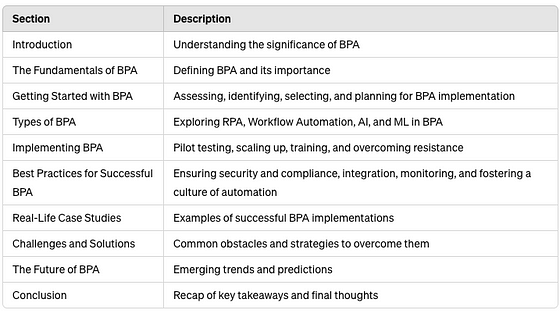
The Fundamentals of Business Process Automation
Defining Business Processes and Business Process Automation
A business process is a sequence of tasks and activities that produce a specific outcome or achieve a defined result. It involves a series of steps that are performed in a specific order to achieve a particular goal, such as producing a product, assimilating new employees, or bringing on new customers.
Business processes typically span multiple departments within an organization, often beginning with an action or trigger that sets off a chain of events.
For instance, in employee onboarding, the HR system might trigger a set of predefined workflow steps to send out a welcome email, configure security credentials, and set up financial details in the compensation system.
Business process automation (BPA) is the strategic use of technology to automate these business processes with minimal human intervention. It involves the use of software tools to automate repetitive, multistep business transactions, thereby increasing efficiency, reducing costs, and enhancing customer satisfaction.
BPA is particularly effective for processes that involve multiple steps, require compliance with regulations, or involve high volumes of data entry. By automating these tasks, organizations can streamline workflows, improve productivity, and minimize human error, ultimately leading to improved overall performance and competitiveness.
Exploring the Significance of Business Process Automation
This table summarizing the key benefits of business process automation:
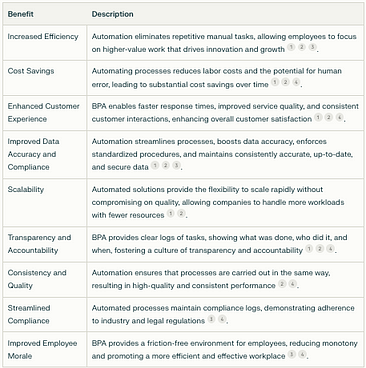
Delving into Business Process Automation: What You Need to Know
Business process automation (BPA) is the strategic use of technology to automate repetitive, multistep business transactions, thereby increasing efficiency, reducing costs, and enhancing customer satisfaction.
By leveraging software to automate tasks, organizations can streamline workflows, improve productivity, and minimize human error. This approach is particularly effective for processes that involve multiple steps, require compliance with regulations, or involve high volumes of data entry.
BPA is one of the fastest growing technologies today, as companies need to do more with less and ensure that their processes are as effective and efficient as possible. BPA refers to the use of software to minimize and enhance human effort within a specific business process.
Since each process is composed of a series of tasks and workflows, the primary goal of BPA is the automation of as many elements of the process as possible.
BPA software is sometimes called low-code automation, as it enables end users to train and deploy automation bots without the need for development skills.
BPA solutions are customized for a specific organization, typically integrated into data systems or connected to APIs. Both BPA and robotic process automation (RPA) solutions increasingly use artificial intelligence (AI) and machine learning technologies to better interpret unstructured data like emails, images, and audio files, leading to a personalized user experience.
Getting Started with Business Process Automation
Assessing Your Current Business Processes for Business Process Automation Opportunities
Assessing your current business processes for business process automation opportunities involves a systematic evaluation to identify tasks that are repetitive, time-consuming, and prone to human error. Start by defining all processes within your organization and mapping out the steps involved in each process.
Look for tasks that consume a significant amount of time, are repetitive, or involve interactions with external parties. Additionally, consider processes that require multiple steps or involve data entry across different systems.
By analyzing these criteria and involving key stakeholders in the assessment, you can pinpoint areas where automation can streamline workflows, improve efficiency, and enhance overall productivity, ultimately paving the way for successful business process automation implementation.
Identifying Automation Opportunities within Your Business Processes
This table provides a concise overview of the key criteria to consider when identifying automation opportunities within your business processes:
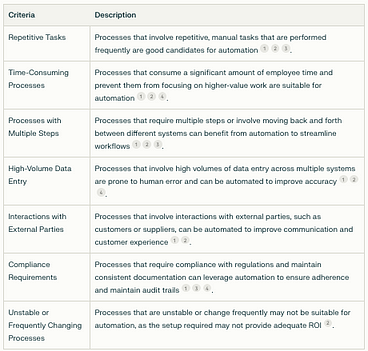
Selecting the Right Automation Tools for Your Business Process Automation Needs
When selecting the right automation tools for your business process automation needs, it’s crucial to consider the specific requirements and goals of your organization.
The choice of automation tools should align with the complexity of your processes, the level of integration required, and the technical expertise of your team.
For simple, repetitive tasks, low-code or no-code automation tools like Microsoft Power Automate or Appian can be effective. These tools often provide pre-built templates and drag-and-drop interfaces, making it easier for business users to create automated workflows with minimal technical knowledge.
However, for more complex processes that involve multiple systems, integrations, and decision-making, you may need to consider more robust business process management (BPM) tools like Pega or IBM Business Process Manager.
These tools offer advanced features such as process modeling, simulation, and analytics, but may require more technical expertise to implement and maintain. It’s also important to consider factors such as scalability, security, and vendor support when selecting automation tools to ensure long-term success and ROI.
Creating a Roadmap for Business Process Automation Implementation
This table provides a structured overview of the key steps involved in creating a roadmap for business process automation implementation:
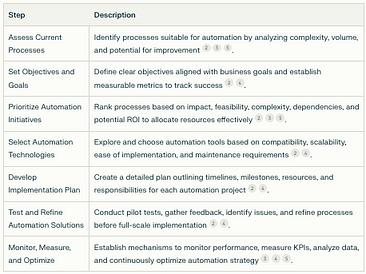
Building a Business Case for Business Process Automation Adoption
Building a compelling business case for business process automation adoption involves articulating the benefits, costs, and potential return on investment (ROI) to secure buy-in from stakeholders.
Start by identifying specific pain points or inefficiencies in current processes that automation can address, such as manual data entry errors, lengthy approval cycles, or high operational costs.
Quantify these inefficiencies in terms of time, resources, and potential revenue impact to demonstrate the need for automation. Highlight how automation can streamline workflows, improve accuracy, reduce costs, and enhance customer satisfaction.
Additionally, outline the potential ROI by estimating the savings in labor costs, increased productivity, and revenue growth that automation can bring. Present a clear roadmap detailing the expected outcomes, timeline for implementation, and key performance indicators (KPIs) to measure success.
Furthermore, emphasize the strategic advantages of business process automation, such as increased agility, scalability, and competitiveness in a rapidly evolving business landscape.
Showcase how automation can free up employees to focus on higher-value tasks, foster innovation, and drive business growth. Address potential concerns around implementation challenges, change management, and integration with existing systems by outlining mitigation strategies and showcasing successful case studies or pilot projects.
By presenting a comprehensive business case that aligns with organizational goals, demonstrates a clear ROI, and addresses potential risks, you can secure the necessary support and resources to successfully adopt business process automation and drive transformative change within your organization.
Types of Business Process Automation
Understanding Robotic Process Automation (RPA) in Business Process Automation:
Robotic Process Automation (RPA) is a pivotal component of Business Process Automation, leveraging software robots or artificial intelligence agents to automate tasks based on predefined workflows.
Unlike artificial intelligence, RPA follows predetermined sequences of actions to streamline processes. RPA systems observe users performing tasks in graphical user interfaces (GUI) and replicate these actions directly within the GUI, simplifying automation in products lacking APIs.
While RPA offers benefits like cost efficiency and performance consistency, it requires continual technical support to adapt to new conditions, limiting its autonomous adaptability and efficiency.
The distinction between RPA and AI lies in their operational focus: RPA reproduces human-directed tasks, while AI processes data to make predictions, showcasing the unique operational approaches of these automation technologies.
Workflow Automation: A Key Component of Business Process Automation
Workflow automation plays a fundamental role in Business Process Automation by orchestrating, extending, and optimizing processes with defined business rules.
It provides a comprehensive view of end-to-end business processes, enabling the connection of tasks within workflows and across business processes.
Business Process Management (BPM) serves as the canvas for mapping out ideal processes, leveraging technology to streamline workflows and drive efficiency.
In contrast, Robotic Process Automation (RPA) complements BPM by automating individual tasks with low-code technology tools, enhancing production efficiency, accuracy, and freeing employees from repetitive tasks.
By combining BPM for strategic process management and RPA for task automation, organizations can achieve seamless end-to-end automation, optimizing processes and enhancing operational efficiency across various sectors.
Leveraging Artificial Intelligence (AI) and Machine Learning (ML) in Business Process Automation
Artificial Intelligence (AI) and Machine Learning (ML) are revolutionizing Business Process Automation by enabling intelligent automation through technologies like Robotic Process Automation (RPA).
Intelligent RPA integrates AI and ML capabilities to automate cognitive tasks, enhancing automation beyond predefined and repetitive activities. By applying AI tools such as machine learning models and natural language processing, intelligent RPA facilitates hyperautomation, rapidly identifying, vetting, and automating business and IT processes.
This advanced automation can process semi-structured and unstructured data, interpret screens, and engage in conversations with users, showcasing the transformative potential of AI and ML in driving efficiency and innovation within business processes.
Industry-Specific Applications of Business Process Automation: Enhancing Efficiency Across Sectors
Business Process Automation offers tailored solutions across various industries, enhancing efficiency and productivity. In the healthcare sector, automation streamlines patient data management, appointment scheduling, and billing processes, improving operational efficiency and patient care.
In finance, automation optimizes loan processing, risk assessment, and compliance tasks, reducing manual errors and accelerating decision-making. Retail industries leverage automation for inventory management, order processing, and customer service, enhancing operational agility and customer satisfaction.
Additionally, in manufacturing, automation optimizes supply chain management, production processes, and quality control, driving cost savings and operational excellence.
By customizing Business Process Automation to industry-specific needs, organizations can achieve significant improvements in efficiency, accuracy, and customer service, positioning themselves for success in today’s competitive landscape.
Implementing Business Process Automation
Pilot Testing and Proof of Concept: Implementing Business Process Automation
Pilot testing and proof of concept are crucial steps in implementing Business Process Automation (BPA) to ensure successful deployment and scalability.
By conducting pilot tests, organizations can validate the effectiveness of automation solutions in real-world scenarios, identify potential challenges, and refine processes before full-scale implementation.
Proof of concept allows stakeholders to visualize the benefits of automation, gain buy-in, and demonstrate the value of BPA in improving efficiency, reducing errors, and enhancing productivity.
Through pilot testing and proof of concept, organizations can fine-tune their automation strategies, address any issues proactively, and lay a strong foundation for successful BPA adoption and expansion.
Training Employees for Business Process Automation Adoption: Empowering Your Team for Success
Empowering employees through comprehensive training is essential for successful Business Process Automation (BPA) adoption. Training programs should focus on building the necessary skills and competencies to effectively utilize automation tools, understand new processes, and adapt to changing workflows.
By providing hands-on training, workshops, and resources, organizations can ensure that employees are equipped to embrace automation technologies, leverage their full potential, and drive innovation within the organization.
Additionally, fostering a culture of continuous learning and encouraging collaboration between employees and automation technologies can enhance employee engagement, boost morale, and facilitate a smooth transition towards a more automated and efficient work environment.
Scaling Up Automation Solutions: Advancing Your Business Process Automation Initiatives
Here is a short table summarizing key steps for scaling up automation solutions in Business Process Automation initiatives:
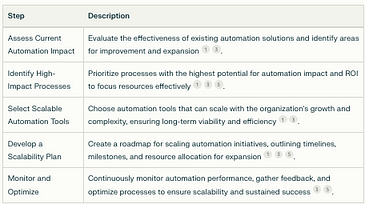
Overcoming Resistance to Change: Strategies for Successful Business Process Automation Adoption
Here is a short table summarizing strategies for overcoming resistance to change during Business Process Automation adoption:
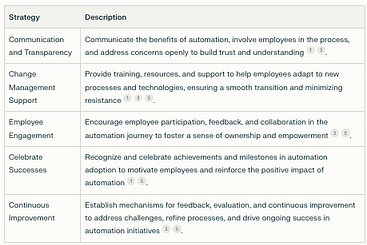
Best Practices for Successful Business Process Automation
Ensuring Data Security and Compliance in Business Process Automation:
Ensuring data security and compliance in Business Process Automation (BPA) is critical to safeguard sensitive information and adhere to regulatory requirements. Organizations must implement robust security measures such as encryption, access controls, and audit trails to protect data integrity and confidentiality.
Compliance automation tools can simplify regulatory adherence by incorporating security controls and automating data protection measures, ensuring compliance with standards like GDPR and PCI DSS.
By prioritizing data security and compliance in BPA initiatives, organizations can mitigate risks, enhance accountability, and maintain trust with customers and regulatory bodies.
Integrating Business Process Automation with Existing Systems for Seamless Operations:
Here is a short table summarizing key considerations for integrating Business Process Automation with existing systems:
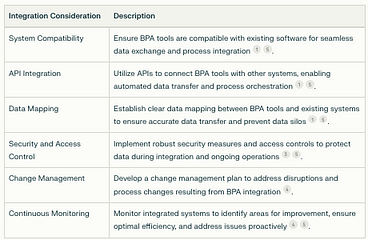
Real-Life Case Studies and Success Stories
Case Study 1: SwiftTech Solutions Implements RPA for Invoice Processing
Background: SwiftTech Solutions, a leading technology firm, faced challenges with manual invoice processing, leading to delays and errors in payments.
Solution: They implemented Robotic Process Automation (RPA) software to automate the invoice processing workflow. The software extracted data from invoices, validated them against existing records, and initiated payment approvals automatically.
Results:
- Reduced invoice processing time by 70%
- Eliminated errors and discrepancies in invoice data
- Improved cash flow management and vendor relationships
Case Study 2: Zenith Services Streamlines Customer Support with Workflow Automation
Background: Zenith Services, a global service provider, struggled with inefficient customer support processes, resulting in long response times and customer dissatisfaction.
Solution: They implemented workflow automation tools to streamline their customer support operations. Automated ticket routing, predefined response templates, and AI-powered chatbots were integrated to handle customer queries efficiently.
Results:
- Reduced average response time by 50%
- Increased customer satisfaction scores by 30%
- Enabled support agents to focus on complex issues, improving overall service quality
Case Study 3: FutureTech Innovations Leverages AI for Predictive Maintenance: Business Process Automation in Action
Background: FutureTech Innovations, a manufacturing company, faced downtime and maintenance costs due to reactive maintenance practices.
Solution: They implemented AI-powered predictive maintenance solutions to monitor equipment health in real-time. Machine learning algorithms analyzed historical data and sensor readings to predict equipment failures before they occurred.
Results:
- Reduced unplanned downtime by 60%
- Cut maintenance costs by 40%
- Extended equipment lifespan and improved production efficiency
Challenges and Solutions in Business Process Automation
Common Challenges in Business Process Automation Implementation: Overcoming Hurdles for Success
Implementing Business Process Automation (BPA) comes with common challenges that organizations must overcome to achieve success. Some of these challenges include the inability of automation to fix underlying process issues, undefined success metrics, stumbling scaling efforts without a clear plan, lack of employee buy-in, and post-deployment pitfalls.
To address these hurdles, organizations can focus on refining processes before automation, clearly defining success criteria, developing a comprehensive scaling strategy, engaging employees in the automation journey, and proactively addressing post-implementation challenges.
By tackling these challenges head-on and implementing effective solutions, organizations can navigate the complexities of BPA implementation and drive successful automation initiatives that deliver tangible benefits and efficiencies.
Strategies for Overcoming Business Process Automation Challenges: Achieving Optimal Results
Here is a short table summarizing key strategies for overcoming challenges in Business Process Automation implementation to achieve optimal results:
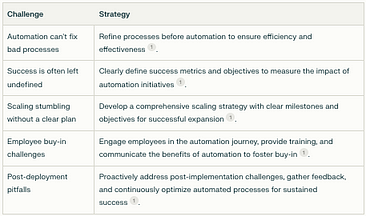
The Future of Business Process Automation
Emerging Trends and Technologies in Business Process Automation: Shaping the Future of Work
Emerging technologies are revolutionizing the way businesses operate, making processes more efficient, data-driven, and adaptable to changing market demands.Business process automation (BPA) is at the forefront of this transformation, leveraging cutting-edge tools and strategies to streamline workflows, enhance productivity, and drive innovation.
Unlock the potential of your business with Edge! . Get started now for a brighter future!
Key trends shaping the future of BPA include the increasing adoption of artificial intelligence (AI) and machine learning (ML) to automate cognitive tasks and enable intelligent automation.
Cloud-based solutions are becoming more prevalent, providing scalability and accessibility. Additionally, there is a growing emphasis on system and data integration to break down barriers between systems, facilitate smooth data flow, and expand the scope of automation possibilities.
As businesses continue to embrace these emerging trends and technologies, they can expect to see significant improvements in efficiency, cost savings, and overall competitiveness in the rapidly evolving business landscape.
Predictions for the Future of Work: Embracing Innovation in Business Process Automation
In the future of work and business process automation, we can expect increased empowerment of business users in driving process improvements, a heightened focus on compliance standards with the integration of generative AI, the consolidation of technologies into comprehensive platforms, a shift towards customer-centric automation, and a greater reliance on data analytics for informed decision-making.
This evolution will also see the emergence of new roles centered around AI implementation and maintenance, improved employee performance through task automation, a rising demand for AI-related skills, democratized access to digital tools for frontline workers, and the integration of analytics within intelligent digital workspaces to significantly enhance productivity and efficiency in the workplace.
Q&A: Mastering Business Process Automation
What are the key benefits of Business Process Automation? — Increased efficiency, reduced costs, enhanced customer satisfaction, improved compliance, and streamlined data management.
How can organizations overcome resistance to change during BPA implementation? — By effective communication, employee engagement, training, and continuous improvement strategies to foster buy-in and support.
What role does data security and compliance play in BPA? — Crucial for protecting sensitive information, ensuring regulatory adherence, and maintaining trust with customers and regulatory bodies.
How can organizations ensure seamless integration of BPA with existing systems? — By ensuring system compatibility, utilizing APIs, clear data mapping, robust security measures, and change management strategies.
What is the future outlook for Business Process Automation? — Continued growth with increased focus on AI, data analytics, customer-centric automation, and democratized access to digital tools for frontline workers.
Conclusion: The Bottom Line
Let’s Recap The Key Takeaways: Mastering Business Process Automation
Throughout this comprehensive guide, we have explored the fundamental aspects of Business Process Automation (BPA) and its transformative impact on modern organizations. Key takeaways include:
- Understanding the significance of BPA in driving efficiency, reducing costs, and enhancing customer satisfaction
- Identifying suitable processes for automation and assessing current workflows for optimization opportunities
- Selecting the right automation tools based on organizational needs, complexity, and technical expertise
- Creating a roadmap for successful BPA implementation, including pilot testing, proof of concept, and scalability planning
- Overcoming resistance to change through effective communication, employee engagement, and change management support
- Ensuring data security and compliance by incorporating robust security measures and automating compliance workflows
- Integrating BPA with existing systems for seamless operations, leveraging APIs and data mapping
- Continuously monitoring and optimizing automated processes to sustain efficiency and drive ongoing improvement
- Building a culture of automation that fosters innovation, collaboration, and continuous learning
My Point of view on Business Process Automation

In my view, business process automation represents the cornerstone of modern organizational efficiency and agility. By seamlessly integrating technology into everyday workflows, businesses can not only streamline operations but also unlock new levels of productivity and innovation.
From reducing manual errors to enabling data-driven decision-making, automation empowers companies to adapt swiftly to evolving market demands while fostering a culture of continuous improvement.
Embracing business process automation isn’t just about optimizing processes; it’s about cultivating a dynamic environment where employees can focus on high-value tasks, driving sustainable growth and competitive advantage in today’s fast-paced business landscape.
Final Thoughts on Mastering Business Process Automation: Empowering Your Business for Success
As we look to the future, it is clear that Business Process Automation will continue to shape the way organizations operate, driving innovation, enhancing productivity, and empowering employees to focus on higher-value tasks.
By embracing emerging trends and technologies, such as artificial intelligence, machine learning, and cloud-based solutions, businesses can stay ahead of the curve and maintain a competitive edge in an increasingly dynamic market.
To master BPA and achieve optimal results, organizations must adopt a strategic and holistic approach, aligning automation initiatives with overall business objectives, engaging stakeholders at all levels, and fostering a culture of continuous improvement and innovation.
By doing so, businesses can unlock the full potential of BPA, transforming their operations, enhancing customer experiences, and positioning themselves for long-term success in the rapidly evolving digital landscape.
Keywords: